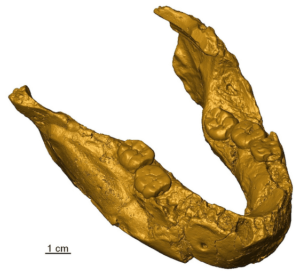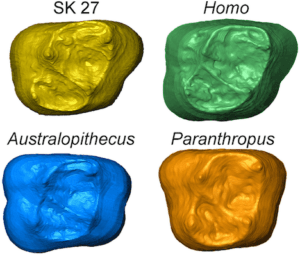
PROCEEDINGS OF THE NATIONAL ACADEMY OF SCIENCES—A study* finds evidence suggesting that only four to seven of 23 purported fossil Homo specimens from southern Africa belong to the genus Homo, with the others sharing traits with other hominin lineages. Identifying the origin and extent of early Homo species can help uncover the selective pressures that may have led to the speciation of Homo and the evolutionary relationships between early Homo, Australopithecus, and Paranthropus. Clément Zanolli and colleagues examined the internal structure of teeth attributed to Early Pleistocene Homo specimens from the Sterkfontein, Swartkrans, Drimolen, and Kromdraai B hominin-bearing sites in southern Africa. Using microcomputed tomography and 3D geometric morphometrics, the authors analyzed taxonomically relevant tooth structures from 23 specimens, finding that only four of the specimens—three from Swartkrans and one from Sterkfontein—were unambiguously Homo specimens. Three additional Sterkfontein samples contained derived Homo features but also retained some Australopithecus-like traits, and the remaining specimens exhibited only Australopithecus or Paranthropus features. The results prompt a re-evaluation of purported Homo specimens, particularly specimens with a geochemical profile that previously suggested a diversity of diet and ecology in Homo species but that are likely properly interpreted as consistent with the profile of Australopithecus. According to the authors, correct taxonomic interpretation of hominin samples could illuminate the development and expansion of Homo species in the Early Pleistocene Epoch.
_____________________________

The mandible SK 15, previously attributed to Homo erectus, and more likely representing a species of robust australopith. Clément Zanolli
_____________________________

The enamel-dentine junction of the second maxillary molar of the human specimen SK 27 compared with those of early Homo, Australopithecus, and Paranthropus. Clément Zanolli
_____________________________
Article Source: PNAS news release.
*“Dental data challenge the ubiquitous presence of Homo in the Cradle of Humankind,” by Clément Zanolli et al., Proceedings of the National Academy of Sciences, 4-Jul-2022. https://www.pnas.org/cgi/doi/10.1073/pnas.2111212119
_____________________________
Advertisement




